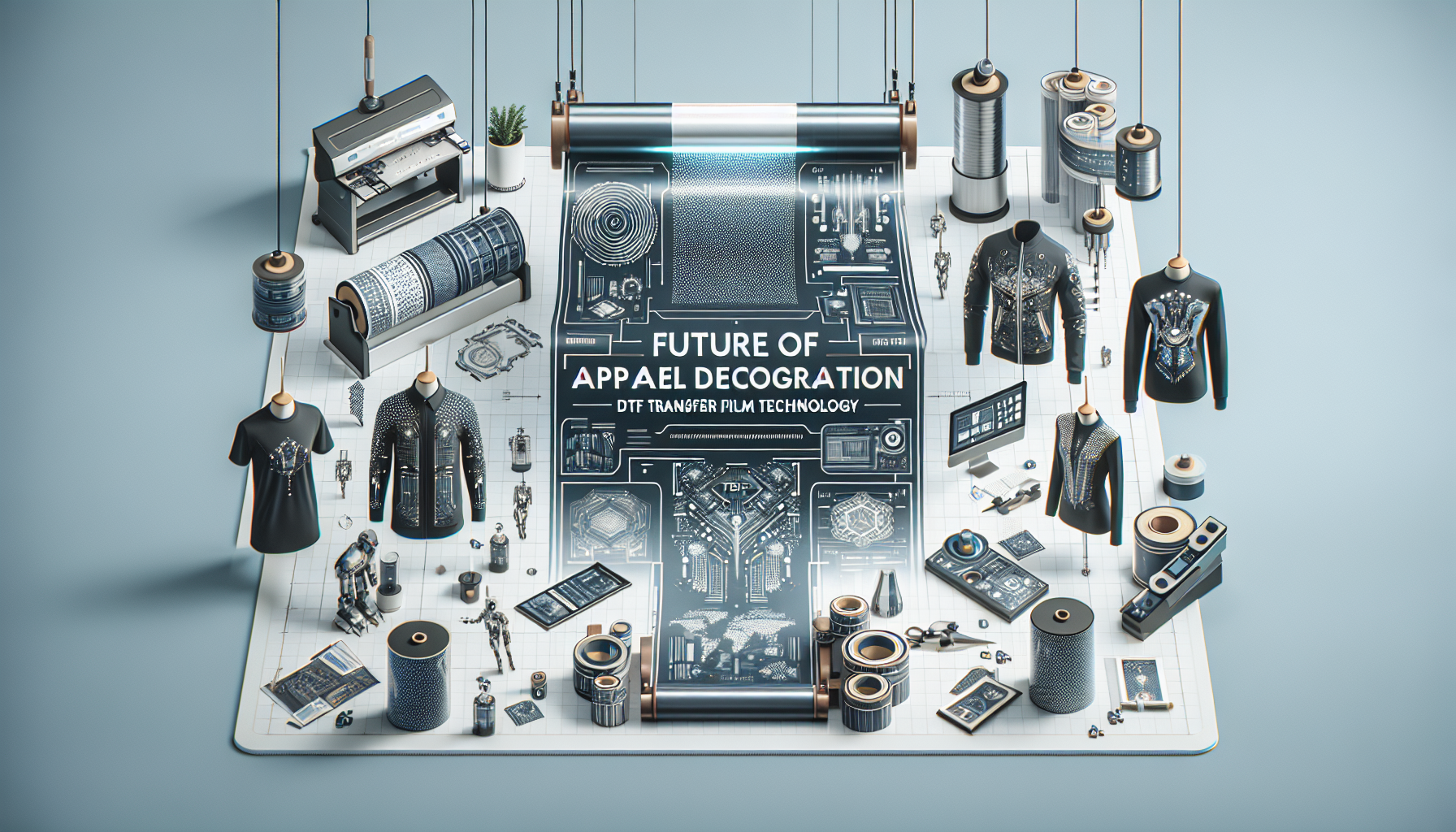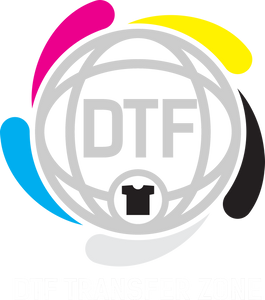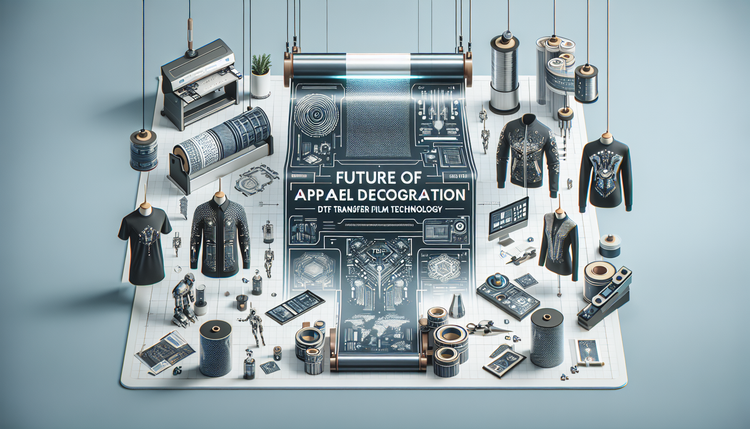Introduction

Apparel decoration has become an essential aspect of the fashion industry, enhancing the appeal of clothing and accessories. Traditional methods, such as screen printing and embroidery, have long dominated the market. However, the advent of DTF (Direct-to-Film) transfer film technology has revolutionized the landscape, offering exciting possibilities for the future of apparel decoration.
What is DTF Transfer Film Technology?
DTF transfer film technology has emerged as a game-changing innovation in the apparel decoration industry. It is centered around direct-to-film (DTF) printing, a technique that involves printing a design onto a special film before transferring it onto the fabric. This method offers several advantages over traditional printing techniques, such as increased versatility, reduced costs, and improved efficiency.
The role of DTF transfer film in the printing process is crucial, as it serves as the medium for carrying the design from the printer to the garment. The film is coated with a layer of adhesive powder, which bonds the ink to the fabric during the heat pressing stage. This ensures a durable, high-quality print that can withstand multiple washes and wear.
DTF transfer film technology stands out when compared to other printing methods like Direct-to-Garment (DTG) and sublimation. While DTG printing involves applying ink directly onto the garment, DTF printing allows for greater flexibility in terms of substrate materials and colors. On the other hand, sublimation printing requires specific fabric types, limiting its applicability. Overall, DTF transfer film technology offers a compelling alternative that can cater to a wider range of apparel decoration needs.
The DTF Printing Process
Understanding the DTF printing process is crucial for achieving high-quality results in apparel decoration. This process involves several key components and steps, which we will explore in detail in this section.
Key Components Involved in DTF Printing
The main components required for DTF printing include:
- DTF printer and software: A specialized printer designed for DTF printing, along with the necessary software to manage the printing process and create designs.
- PET films and hot melt adhesive powder: PET films serve as the medium for transferring designs, while the hot melt adhesive powder is applied to the film to ensure proper adhesion of the ink to the fabric during the heat pressing stage.
- Printing inks and heat press: High-quality inks compatible with DTF printing are essential for creating vibrant, durable prints. A heat press is used to transfer the design from the film to the garment, activating the adhesive and bonding the ink to the fabric.
Step-by-Step Guide to DTF Printing
Here is a general overview of the DTF printing process:
- Create the design using the appropriate software and prepare it for printing.
- Load the PET film into the DTF printer and apply the hot melt adhesive powder to the film.
- Print the design onto the film using the DTF printer and inks.
- Position the printed film onto the garment, ensuring proper alignment and placement of the design.
- Use the heat press to transfer the design onto the garment, activating the adhesive and bonding the ink to the fabric.
- Peel away the film, revealing the final printed design on the garment.
Factors Affecting the Quality of DTF Prints
Several factors can influence the quality of DTF prints, including:
- The quality and compatibility of the DTF printer, software, and inks used in the process.
- The correct application and amount of hot melt adhesive powder on the PET film.
- Proper alignment and positioning of the film on the garment during the heat pressing stage.
- The heat press settings, including temperature, pressure, and duration, which can affect the adhesion and appearance of the final print.
By paying close attention to these factors and following best practices, it is possible to achieve consistent, high-quality results with DTF transfer film technology.
Setting Up for DTF Printing
Before diving into DTF printing, it is essential to ensure that you have the right equipment and consumables, a well-prepared workspace, and the necessary training for your team. These factors will not only impact the quality of your prints but also the overall efficiency and safety of your printing operation.
Selecting the Right Equipment and Consumables
Investing in high-quality equipment and consumables is crucial for achieving the best results with DTF printing. This includes a specialized DTF printer designed specifically for this printing technique, compatible software to manage the printing process and create designs, PET films and hot melt adhesive powder for transferring the designs, and high-quality inks that provide vibrant, durable prints. It's essential to research and compare different products on the market to find the best fit for your specific needs and budget.
Preparing the Workspace and Ensuring Safety Measures
A well-organized and safe workspace is vital for efficient and successful DTF printing operations. Ensure that your workspace is clean, well-lit, and free of clutter, with adequate ventilation to maintain a healthy working environment. It's also important to establish safety guidelines and protocols for your team, such as proper handling of chemicals and equipment, personal protective equipment (PPE) requirements, and emergency procedures in case of accidents or spills.
Training and Labor Requirements for DTF Printing
While DTF printing offers several advantages over traditional printing methods, it also comes with a learning curve for mastering the techniques involved. Providing comprehensive training for your team is essential to ensure that they are familiar with the equipment, software, and processes required for DTF printing. This may involve attending workshops, webinars, or other educational resources, as well as hands-on practice with the equipment. Additionally, it's important to consider the labor requirements for your DTF printing operation, as this can impact the overall efficiency and cost-effectiveness of your business.
Understanding the Costs of DTF Printing
When considering the implementation of DTF printing in your business, it's essential to have a clear understanding of the costs involved. This includes equipment, consumables, and labor costs, as well as the potential return on investment (ROI) and how these costs compare to other decoration methods.
Equipment, Consumables, and Labor Costs
The costs of DTF printing can be broken down into three primary categories: equipment, consumables, and labor. Equipment costs include the initial investment in a DTF printer, software, and heat press. Consumables encompass the ongoing expenses for PET films, hot melt adhesive powder, and printing inks. Labor costs account for the time and expertise needed to operate and maintain the DTF printing equipment and processes. It's crucial to carefully analyze and estimate these costs when planning your DTF printing operation.
Return on Investment (ROI) Calculation Samples
To evaluate the profitability of implementing DTF printing, you can calculate your potential ROI by comparing the costs and revenues generated from this printing method. This involves estimating the expenses for equipment, consumables, and labor, as well as projecting the sales and profit margins for your DTF-printed products. By analyzing these ROI calculations, you can determine whether DTF printing is a viable and profitable option for your business.
Comparing the Costs of DTF Printing with Other Decoration Methods
When weighing the costs of DTF printing, it's also important to compare them with alternative decoration methods, such as screen printing, embroidery, and sublimation. Each method comes with its own set of costs and benefits, and the best choice for your business will depend on factors such as your target market, product offerings, and production capabilities. By conducting a thorough cost comparison, you can make an informed decision about the most suitable and cost-effective decoration method for your specific needs.
Benefits of DTF Transfer Film Technology
DTF transfer film technology offers numerous advantages over traditional apparel decoration methods, making it an increasingly popular choice for businesses and designers alike. In this section, we will explore the key benefits of this innovative printing technique, including its versatility, cost-effectiveness, efficiency, and compatibility with a wide range of materials and inks.
Versatility and Graphics Quality
One of the most significant advantages of DTF transfer film technology is its versatility, allowing for high-quality prints on various garment materials and colors. This opens up new creative possibilities for designers and businesses, as they can offer unique and customized products to their customers. Additionally, DTF printing can produce intricate designs with sharp details and vibrant colors, rivaling traditional screen printing and embroidery in terms of graphics quality.
Cost-Effectiveness
DTF printing can be more cost-effective than other decoration methods, particularly for small- to medium-sized production runs. The elimination of screens and the reduced need for multiple ink colors contribute to lower setup costs. Moreover, the efficient use of ink and the ability to print directly onto a transfer film result in reduced ink waste, further contributing to the cost savings.
Efficiency and Faster Setup Time
Another key benefit of DTF transfer film technology is its efficiency and faster setup time compared to other printing methods. The direct-to-film printing process eliminates the need for screens, reducing the time and labor required for setup. Additionally, digital design files can be easily adjusted and printed on-demand, allowing businesses to respond quickly to customer requests and market trends.
Compatibility with Various Garment Materials and Ink Types
DTF transfer film technology is compatible with a wide range of garment materials, including cotton, polyester, and blends. This makes it a versatile choice for apparel decoration, as it can cater to various customer preferences and product requirements. Furthermore, DTF printing inks are designed to bond well with different fabric types, ensuring durable and long-lasting prints that can withstand multiple washes and wear.
In conclusion, the benefits of DTF transfer film technology make it a promising option for the future of apparel decoration. By embracing its versatility, cost-effectiveness, efficiency, and compatibility, businesses can capitalize on the growing demand for customized and high-quality printed garments in the fashion industry.
Limitations and Challenges of DTF Printing
While DTF transfer film technology offers numerous benefits, it is essential to be aware of the limitations and challenges that may be encountered in its implementation. In this section, we will discuss some of the potential issues in the printing process, garment and ink compatibility concerns, and the learning curve involved in mastering DTF printing techniques.
Possible issues that may arise during the DTF printing process include misalignment or wrinkling of the PET film, leading to suboptimal transfers, as well as the risk of ink smudging or fading over time. Ensuring proper alignment, pressure, and heat settings during the heat pressing stage can help mitigate these issues and improve the overall quality and durability of the prints.
Regarding garment and ink compatibility, while DTF printing works well with various fabric types, certain materials may not bond well with the inks or may require special treatment before printing. Furthermore, some inks may not be suitable for specific fabrics or colors, which could limit the range of products that can be produced using this method. Researching and testing different ink formulations and fabric types can help identify the most compatible combinations for optimal results.
Finally, mastering DTF printing techniques involves a learning curve for both new and experienced printers. Proper training and hands-on practice with the equipment are essential for achieving consistent, high-quality results. This may require investing time and resources in workshops, webinars, or other educational resources to ensure that your team is well-equipped to handle the intricacies of DTF printing.
In conclusion, understanding the limitations and challenges of DTF printing is crucial for businesses looking to adopt this innovative technology. By addressing these concerns and continuously striving to improve and refine your processes, you can maximize the potential of DTF transfer film technology and create a competitive edge in the apparel decoration market.
Not-So-Common Applications of DTF Transfers
While DTF transfer film technology has become increasingly popular for apparel decoration, there are also less commonly explored applications that can showcase the versatility and potential of this innovative technique. In this section, we will discuss some innovative ways to utilize DTF transfer film technology and explore potential growth areas in the apparel decoration market.
One exciting application of DTF transfers is the decoration of unconventional materials and objects, such as shoes, bags, and accessories. With the right equipment and techniques, DTF printing can be adapted to various surfaces and materials, offering unique possibilities for customization and personalization. Additionally, DTF transfers can be used for the creation of promotional items and merchandise, such as branded apparel, corporate gifts, and event giveaways.
Another potential growth area for DTF printing is the use of eco-friendly and sustainable materials in the apparel decoration process. As consumers become increasingly conscious of the environmental impact of their purchases, the demand for sustainable and ethically-produced garments is on the rise. DTF transfer film technology can be adapted to work with environmentally-friendly materials, such as organic cotton, recycled polyester, and biodegradable films, providing an opportunity for businesses to cater to this growing market segment.
Overall, the not-so-common applications of DTF transfers demonstrate the versatility and potential of this innovative technology. By exploring new ways to utilize DTF transfer film technology and tapping into emerging market trends, businesses can stay ahead of the competition and continue to evolve in the dynamic world of apparel decoration.
The Future of Apparel Decoration with DTF Transfer Film Technology
As the apparel decoration industry continues to evolve, DTF transfer film technology is poised to play a significant role in shaping its future. With its numerous advantages and potential applications, this innovative printing technique offers exciting opportunities for growth and development in the world of custom apparel.
Forecasting trends and developments in DTF printing is essential for businesses looking to stay ahead of the curve. Key areas to watch include advancements in printer technology, software, and consumables, as well as the emergence of new applications and market segments. By staying informed and adapting to these trends, businesses can harness the power of DTF transfer film technology to create unique and high-quality products that cater to a diverse range of consumer needs.
Moreover, the role of DTF transfer film technology in the evolution of custom apparel cannot be overstated. With its ability to produce intricate designs on various garment materials and colors, DTF printing has the potential to revolutionize the way businesses approach apparel decoration. This technology can help businesses offer more personalized and customized products, driving customer satisfaction and brand loyalty.
Lastly, the potential impact of DTF transfer film technology on the overall apparel decoration industry is significant. As more businesses adopt this technique and consumers become increasingly aware of its benefits, the demand for DTF-printed products is expected to grow. This, in turn, can drive innovation and competition within the industry, leading to better products and services for customers.
In conclusion, the future of apparel decoration is undoubtedly bright with the advent of DTF transfer film technology. By embracing its potential and staying informed about the latest trends and developments, businesses can create a competitive edge and contribute to the ongoing evolution of the custom apparel market.
DTF Transfer Zone: Leading the Way in DTF Printing Services and Supplies
As the demand for innovative apparel decoration solutions continues to grow, businesses like DTFTransferZone are at the forefront of providing high-quality DTF printing services and supplies. This company is committed to offering a wide range of products and services tailored to the unique needs of its customers.
DTFTransferZone has an extensive array of product offerings designed to meet diverse requirements in the DTF printing industry. Customers can choose from custom DTF transfers, DTF inks, and DTF supplies, all of which are designed to ensure optimal results and satisfaction.
In addition to their core offerings, DTFTransferZone also provides unique holiday gifts and themed heat transfers for various occasions. This includes ready-to-press heat transfers for events like birthdays, Christmas, Halloween, and Valentine's Day, as well as custom-printed apparel like sweatshirts, hoodies, pajama pants, and blankets. This comprehensive selection of products enables customers to find the perfect solution for their apparel decoration needs, whether they are looking for a personalized gift or a creative way to promote their brand.
Ultimately, DTFTransferZone is dedicated to leading the way in DTF printing services and supplies, offering customers a one-stop-shop for all their apparel decoration needs. By focusing on quality, innovation, and customer satisfaction, DTFTransferZone is helping to shape the future of apparel decoration and contribute to the ongoing success of the DTF transfer film technology industry.
Conclusion
As the apparel decoration industry continues to evolve, the rising prominence of DTF transfer film technology is playing a pivotal role in shaping its future. Embracing the advantages and overcoming the challenges of DTF printing is crucial for businesses looking to adopt this innovative method. By mastering the techniques involved and continuously refining their processes, companies can capitalize on the unique benefits of DTF transfer film technology, such as versatility, cost-effectiveness, and efficiency.
Businesses like DTFTransferZone are leading the way in DTF printing services and supplies, contributing to the ongoing success and growth of the industry. By offering a wide range of products and prioritizing customer satisfaction, DTFTransferZone is helping to shape the future of apparel decoration and paving the way for further advancements in DTF transfer film technology. As more businesses adopt this cutting-edge technique and explore its potential applications, the future of apparel decoration promises to be exciting and full of possibilities.
Discover DTF Transfer Zone
Embrace the future of apparel decoration and enhance your designs by exploring DTFTransferZone's products and services. With their extensive range of DTF transfers, inks, and supplies, as well as unique holiday gifts and themed collections, there's something for every occasion and style. Prioritizing customer satisfaction, DTFTransferZone offers quick shipping, no setup or art fees, and no order minimums. Don't miss the opportunity to elevate your apparel decoration game with DTF transfer film technology. Visit the DTFTransferZone website to learn more and make informed decisions about your next project.

